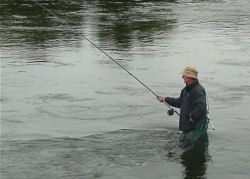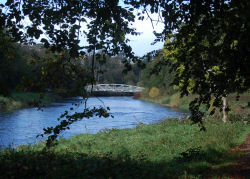Fishing in Tipperary
 In
Ireland, camping and fishing make ideal partners, as also would taking
a caravan holiday combined with a spot of angling. In Tipperary, we are
blessed with the River Suir (pronounced ‘sure’), which rises in the
Devil’s Bit Mountain in Co Tipperary and flows south and then north and
east to join the Barrow and the Nore in Waterford Harbour. It is 115
miles long and together with its tributaries it feeds from a total
catchment of 1,394 square miles.
In
Ireland, camping and fishing make ideal partners, as also would taking
a caravan holiday combined with a spot of angling. In Tipperary, we are
blessed with the River Suir (pronounced ‘sure’), which rises in the
Devil’s Bit Mountain in Co Tipperary and flows south and then north and
east to join the Barrow and the Nore in Waterford Harbour. It is 115
miles long and together with its tributaries it feeds from a total
catchment of 1,394 square miles.The main river lies entirely on limestone except for a few miles at the source and all the tributaries are on limestone, with the exception of the Nire, the Clodiagh and the upper reaches of the Multeen, which comes in from the west near Cashel.
 The
flow in the main river is characterized by deep and shallow glides
interrupted by shallow riffles. Its width increases as it proceeds
downstream and the sequence of relatively shallow glide and riffle is
maintained.
The
flow in the main river is characterized by deep and shallow glides
interrupted by shallow riffles. Its width increases as it proceeds
downstream and the sequence of relatively shallow glide and riffle is
maintained.This combination of a rich limestone base and huge areas of relatively shallow glides makes the Suir ideal for the production of brown trout. There is massive recruitment of young trout from the extensive system of tributaries and the trout survive and grow in what is a near-perfect environment. They have few predators in the form of pike, and coarse fish are almost entirely absent.
The Suir is one of Ireland’s premier brown trout fisheries. Only a handful of rivers can compare with it in terms of numbers of trout produced per square yard and it is unlikely that any river can equal it in terms of the overall numbers of trout that it produces. The best news is that so many of these are available to the angler.
The average size of the trout ranges from 400g to 1.8kg in different areas, depending on the habitat. Their lifespan is relatively short and few trout exceed 4 years of age.
 The
Suir also has a little Salmon fishing, and it is said that the best of
the salmon fishing extends downstream from Ardfinnan towards
Carrick-on-Suir. The fishing is controlled mainly by either angling
clubs or syndicates and very little information is available on the
quality of the fishing. The river still produces occasional spring
salmon and is thought to get a fair run of grilse. In some seasons,
when conditions are right, it gets a good run of 12 – 18 lb (6-9kg)
salmon. The Suir has the distinction of producing Ireland’s record
rod-caught salmon. It weighed 57 lb (26kg) and was taken on a fly by
Michael Maher in 1874. There is very little salmon fishing available to
the general public and the best fishing on what is available is in June
and September.
The
Suir also has a little Salmon fishing, and it is said that the best of
the salmon fishing extends downstream from Ardfinnan towards
Carrick-on-Suir. The fishing is controlled mainly by either angling
clubs or syndicates and very little information is available on the
quality of the fishing. The river still produces occasional spring
salmon and is thought to get a fair run of grilse. In some seasons,
when conditions are right, it gets a good run of 12 – 18 lb (6-9kg)
salmon. The Suir has the distinction of producing Ireland’s record
rod-caught salmon. It weighed 57 lb (26kg) and was taken on a fly by
Michael Maher in 1874. There is very little salmon fishing available to
the general public and the best fishing on what is available is in June
and September. The relative uniformity of the nature of the river-bed type means that the dominant fly hatches are more or less similar over the entire length of the river, with the exception of the mayfly, which is found only between Camus Bridge and Golden, and stoneflies, which are confined to fast shallow sections. Otherwise, from March to late April, there are large dark olives around midday. From late April to mid-May, there are medium olives, iron blues and stoneflies – early brown. From mid-May to mid-June, there are alders, medium olives, reed smuts and midges, mayfly, pale wateries, blue-winged olives, caenis, hawthorn, black gnat, yellow stoneflies and various sedges, including murroughs and grey flags. From mid-June to the end of July sees blue-winged olives, pale wateries and pale evening duns, small dark olives, a variety of sedges (including murrough, cinnamon sedge, red sedge and silverhorns) and ants on occasions. August has similar hatches. The blue-winged olive is very important in the evening, as are various sedges, and trout take small black and green midges by day. In September the trout take blue-winged olives during the day and on mild evenings. Midges, olives and small sedges and the cinnamon sedge are also important.
The peak of the trout fishing is from early May to mid-June for day-long fishing, at dusk for the rest of the summer and during the day and evening in September. At these times, there is usually no shortage of feeding trout.
 In
the Cahir area, only fly fishing is allowed, and no spinning or bubbles
are permitted for trout. The minimum size of trout taken must be 23 cm
or longer (9 inches), and anglers must carry permits at all times, as
waterkeepers are on duty at the river.
In
the Cahir area, only fly fishing is allowed, and no spinning or bubbles
are permitted for trout. The minimum size of trout taken must be 23 cm
or longer (9 inches), and anglers must carry permits at all times, as
waterkeepers are on duty at the river.Naturally, respect must to be shown on all landowners’ property, for example keeping gates closed, and courtesy shown to other Anglers.
Fishing permits for the Cahir area are available from 7am to 11pm at The Heritage Shop, 1, The Square, Cahir. Contact Patrick and Karen O’Donovan – Tel: 052-7442730. These permits cost €20 per day or €75 per week.
These permits allow fishing in the following locations:
· From Suirville to Ballycarron Bridge
· From Ballycarron Convent to Aherlow Point
· From Swiss Cottage to Carrigatha – right and left bank
· Also Cappagh Gates on The Aherlow River to The Meetings
For further information on Cahir and District Anglers’ Association, contact
Kevin Rowe
PRO Cahir and District Anglers’ Association
Reiska Road,
Cahir,
Co Tipperary
Tel: 052-7442729
Mob: 087-6409271
or
Gerry O’Brien
Hon. Secretary Cahir and District Anglers’ Association
Tel: 052-7442684
Paul Burke (087 6452827) and Kevin Rowe (087 6409271) are local angling guides.
Fly tying specialist George McGrath of Cuileoga, The Square, Cahir can supply all your fishing tackle needs. He advises that good fishing is available 4 kms upstream and 4 kms downstream of the bridge in Cahir. George has extensive knowledge of the local rivers - All advice freely given.
Body waders and a wading staff are practically essential for an angler when fishing the main channel of the Suir. In most areas, the bottom is firm and consists of stone, gravel or sand. This is a big river with a strong current and anglers should take due care when wading.
More information on fishing in the Suir here.
Visit the Cahir and District Anglers Association Website.
Local Attractions Page